Darth Vader is standing on a pedestal in the yard of a plant in the suburbs of the southern Ukrainian city of Odesa. In his previous life he was a monument to Lenin, transformed into the Star Wars hero by Ukrainian artist Oleksandr Milov.
More than 25 years after proclaiming its independence from the Soviet Union, Ukraine has said a final goodbye to the symbols of its communist past. Streets and cities named after the heroes of the Soviet regime have now been renamed. As of late 2016 none of the 5,500 monuments of Lenin, the leader of the communist revolution, are standing where they used to.
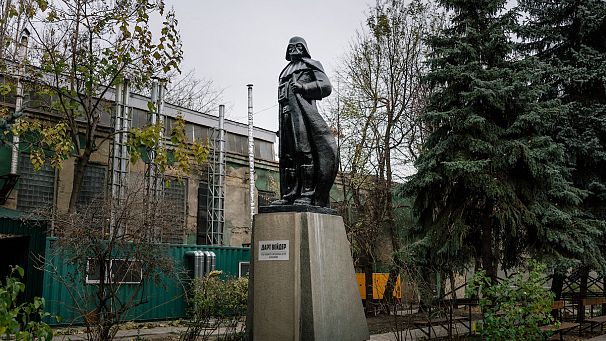
© Niels Ackermann / Lundi13 / Fuel Publishing
But where did the Lenin go?
What happened to him and why? We look closer at the phenomenon of “decommunisation” in modern Ukraine together with Swiss photographer Niels Ackermann and French journalist Sebastien Gobert thanks to their project “Looking for Lenin”. Both lived in Ukraine for more than 6 years and went to search for the demolished statues, finding them in garbage dumps, museums, private backyards, offices, gardens; sometimes with missing heads and limbs, sometimes reincarnated…
The team talked to Ukrainians about Lenin and they had many stories to tell, now published in a book. The project is also on display in Arles, in the south of France, as a part of world famous photography festival Les Rencontres d’Arles.
Euronews’ Natalia Liubchenkova met Niels and Sebastien there. The co-authors explained why Ukrainians transform Lenin into something else and how the country has changed since decommunisation reached its final stage.
Which historic heros?
The communist leader’s monument in the western town of Rivne was removed from the central square the day after Ukrainian independence was proclaimed. It was cut into pieces, melted and recast as a statue of the national poet and patriotic hero Taras Shevchenko. The arm of another Lenin monument was turned into statue dedicated to a Ukrainian race walker, four-time Olympic champion, Volodymyr Holoubnychy. Lenin was also turned into more generic historical figures respected inside the country, who often symbolize Ukrainian identity, like a cossak, for example.
The necessity to deal with the bulky sculptures sometimes resulted in creative ideas of what to do with the monuments and animated discussions around them. The local authorities of Lutsk, a town in northwestern Ukraine, decided to recast Lenin as church bells. The same initiative in Lviv met with fierce resistance from the local communists.
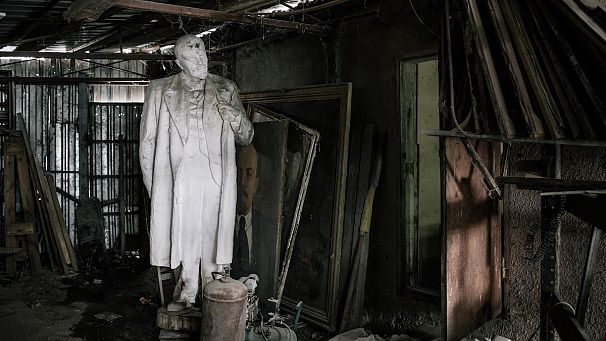
© Niels Ackermann / Lundi13 / Fuel Publishing
The “Looking for Lenin” project started at one particular statue. Ackerman and Gobert were looking for the Lenin statue that was dissected by activists primarily from the Ukrainian nationalist party “Svoboda”, in the centre of Kyiv (near Bessarabska square) on the 8th December 2013. At that times street protests (widely referred to as “Maidan”) calling for then-president Yanukovich to step down were growing stronger. And the fall of Lenin seemed to be a one step closer to the end of the pro-Russian president’s rule.
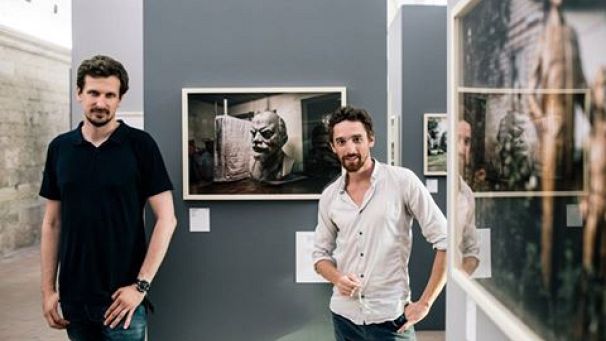
“The fascination for moments when propaganda turns against its creators is probably something that was stuck in my head for many years,” Ackermann told Euronews.
“The fall of the Berlin Wall, the flying Lenin in the film “Goodbye Lenin”, the monument floating along a river by Koudelka all these images were part of my political imaginary since my teenage years. “When I was photographing the crowd striking the Bessarabska Lenin, I felt like I was living one of these magical moments, but to be honest, it was nearly impossible to get any really good pictures at this moment.
Some months later, it all started aggregating in my head around this idea “What’s left of this Lenin?”. There was probably a ridiculous block of marble left somewhere. I wanted to see it. That’s where the whole thing started. I involved Sebastien in the process of looking for this first Lenin.
This quest is by far the hardest as two years after the beginning, we were still not allowed to photograph the big chunk left of this monument. Now we know who stole it, we have a precise idea of where it is but need the permission of his “owner”. In the meantime, we found tons of other Lenins.”
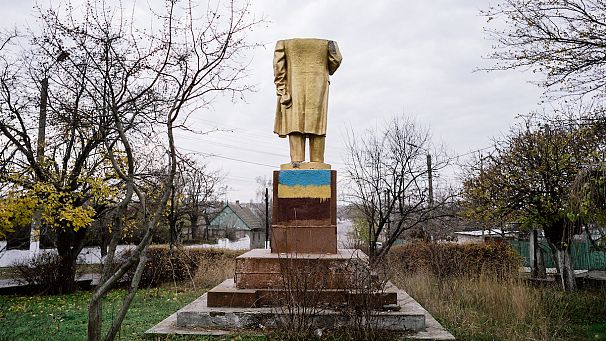
© Niels Ackermann / Lundi13 / Fuel Publishing
As a result of the decommunisation law signed by the President of Ukraine in 2015, the Soviet regime is considered to be a crime, linked to the propagation of a policy of terror. This directive outlaws any propaganda from the regime and therefore any usage of communist symbols. The local authorities were given six months to dismantle communist statues and rename streets and towns.
Uprooted statues of Lenin can be found on side-roads or in private collections sometimes painted in the colours of Ukrainian national flag, like this statue, which was put on sale in the village of Korzhi. A local resident is asking 15,000 dollars for it to renovate the school and kindergarten in the village.
Sebastien Gobert showed us around “Looking for Lenin” exhibition and explained why Ukrainians transform Lenin into something else.
“Many Lenins have been painted in the national colours (yellow and blue). This was a way for people to “ukrainize” Lenin and make him somehow more local and less of a distraction. So this is the something many people wanted to show in a way to point out the irony of history and also preserve some of the statues.”
In the video Gobert also tells the story of the Lenin monument put on sale to renovate a village kindergarten and another Lenin who became a Birthday present.
Lenin in the woods
There is a complicated relationship between people and the monuments representing the history of the region and its contradictory heroes. A significant part of the population campaigned for decommunization from the day independence was confirmed, these Ukrainians believe the measures are long overdue. But there is another part of the population that has a very different opinion about and still revere communist leaders.
Others are indifferent to history or politics; they are simply attached to the monument they grew up alongside. And the two sides are often irreconcilable. Sebastien Gobert tells the story of a statue found in the woods near a town in central Ukraine. The local mayor says he kept good care of Lenin but toppled it when the time came. Some inhabitants of the village subsequently took it into the forest. The statue was later damaged by nationalist activists and the pioneers next to Lenin’s figure are missing their heads.
“The mayor told us the village always liked this statue, because it’s “very innocent”, it’s Lenin teaching children how to read, and so on, so they kind of always liked it. Some of the inhabitants went to put it to the forest, they set up some chairs there and now they go and drink beer by Lenin…”
This photograph shows Lenin lying in the outskirts of town of Kremenchuk in central Ukraine. Sebastien sees it as a perfect illustration of the impact of decommunisation. The statue has been toppled and is hidden from public sight but, in the background the cliche of a Soviet European landscape – the facade of a stern, concrete tower block – is still visible.
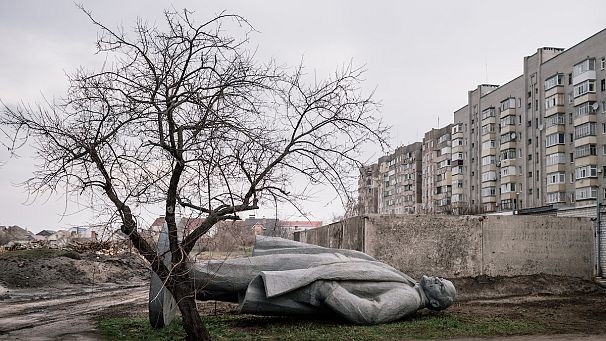
© Niels Ackermann / Lundi13 / Fuel Publishing
The removal of the Lenin statues is just part of a much broader effort to reboot the post-Soviet country as it battles to escape its inheritance of bureaucracy and corruption. While striving to move on with a market-driven economy and pro-western political choice, the presence of thousands of monumental symbols of the troubled past just too often seemed out of place.
The “Looking for Lenin” photographs are in Arles, France, until September 24. They will then visit Winterthur, Switzerland, Essex in the UK and Moscow.
Read more about Lenin’s destinies in our story: 11 imaginative ways Ukraine has dealt with its historic statues
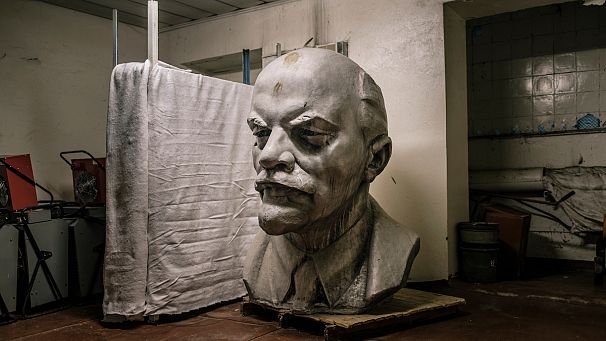
© Niels Ackermann / Lundi13 / Fuel Publishing











